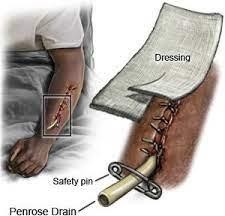A postoperative client has an abdominal incision and a Penrose drain. Both are covered with an abdominal dressing. Which is an important nursing action associated with caring for a client with a Penrose drain?
Changing the soiled dressing carefully
Pinning the drain to the dressing
Allowing the drain reservoir to fill completely before emptying it
Maintaining the negative pressure of the drain
The Correct Answer is C
Choice A rationale: Changing the soiled dressing carefully is important but not specifically associated with caring for a Penrose drain.
Choice B rationale: Pinning the drain to the dressing is not typically done; securing the drain and preventing tension are important.
Choice C rationale: Allowing the drain reservoir to fill completely before emptying it is a crucial nursing action associated with caring for a Penrose drain.
Choice D rationale: Maintaining the negative pressure of the drain is not applicable to a Penrose drain, which relies on gravity drainage.

Nursing Test Bank
Naxlex Comprehensive Predictor Exams
Related Questions
Correct Answer is D
Explanation
Choice A rationale: Maintaining continuous oxygen therapy does not directly address the thinning of respiratory secretions.
Choice B rationale: Maintaining a consistent air temperature in the client's room is not directly related to thinning respiratory secretions.
Choice C rationale: Keeping the client in a supine position as much as possible is not the most helpful action for thinning respiratory secretions.
Choice D rationale: Assisting the client to maintain an adequate fluid intake is the most helpful action in thinning respiratory secretions, promoting hydration and mobilization of secretions.
Correct Answer is D
Explanation
Choice A rationale: Norming is characterized by the development of group cohesion and establishment of norms, not necessarily high-level problem-solving.
Choice B rationale: Storming is marked by conflict and tension within the group, not optimal problem-solving.
Choice C rationale: Forming is the initial stage where members get to know each other; it does not represent a highly functioning team.
Choice D rationale: Performing is the stage where the group is functioning at its highest level, demonstrating effective problem-solving and productivity.

Whether you are a student looking to ace your exams or a practicing nurse seeking to enhance your expertise , our nursing education contents will empower you with the confidence and competence to make a difference in the lives of patients and become a respected leader in the healthcare field.
Visit Naxlex, invest in your future and unlock endless possibilities with our unparalleled nursing education contents today
Report Wrong Answer on the Current Question
Do you disagree with the answer? If yes, what is your expected answer? Explain.
Kindly be descriptive with the issue you are facing.
